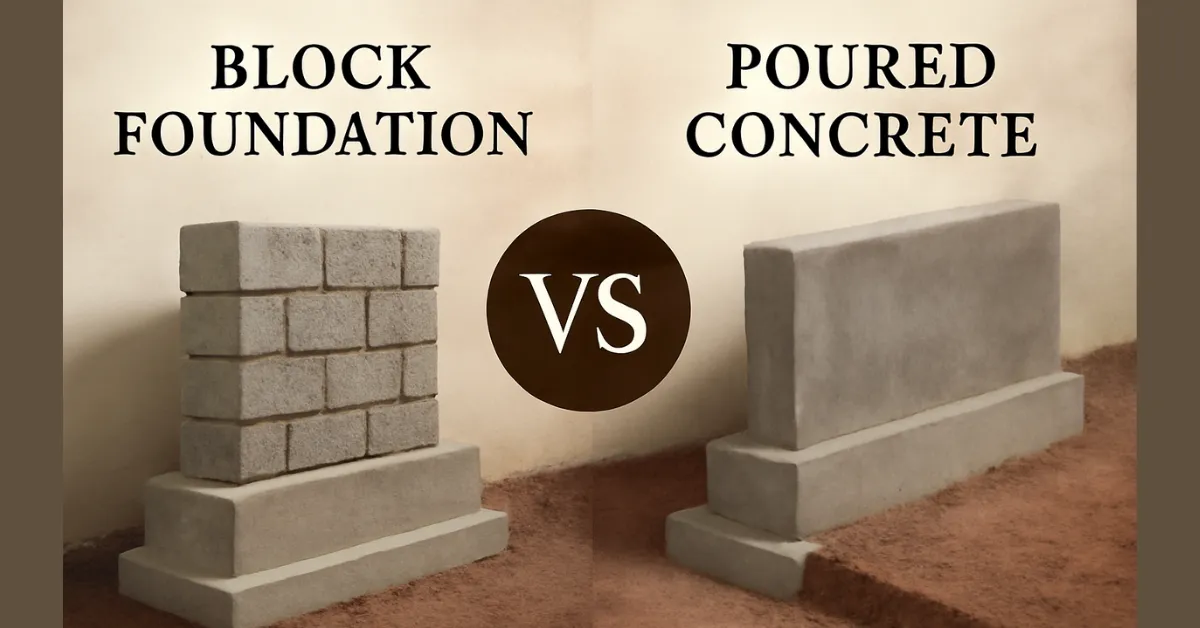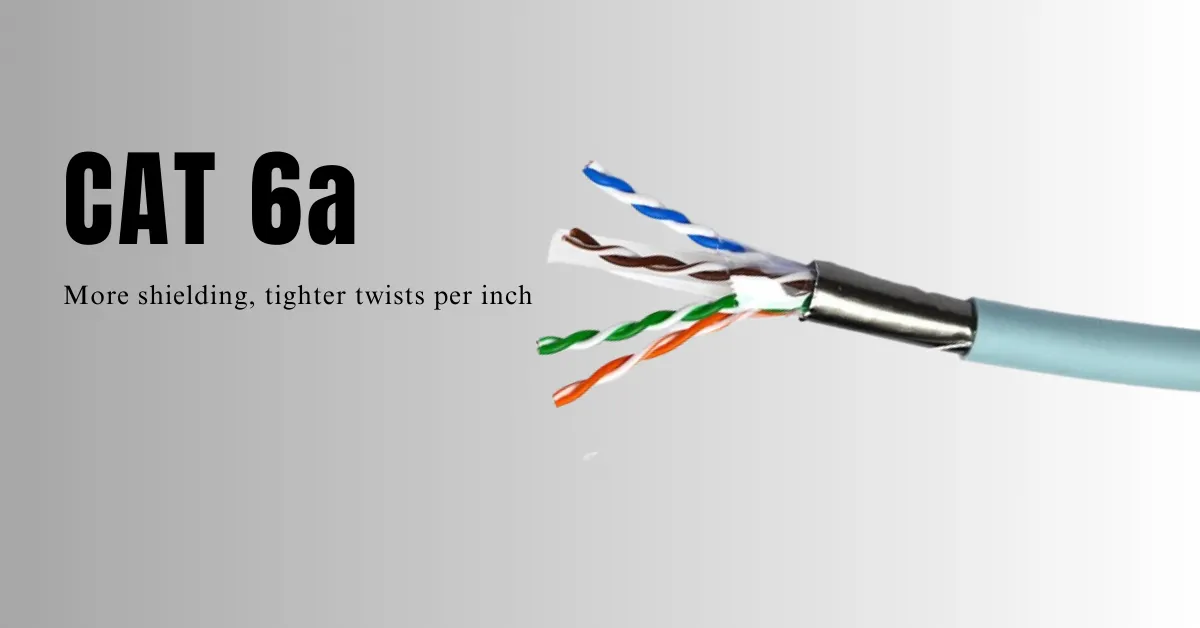Cat 5e Ethernet Cable Max Speed, Specs & Performance Tips
When choosing the right network setup, understanding Cat5e Ethernet cables is crucial. The Cat 5e network cable is designed for modern networks, providing fast and reliable connections.
Its Cat5e cable speed ensures efficient data transfer, with the maximum speed of Cat5e reaching up to 1 Gbps, making it ideal for home or office networks. Curious about how fast Cat5e is? Let’s dive into its capabilities.
What is Cat 5e?
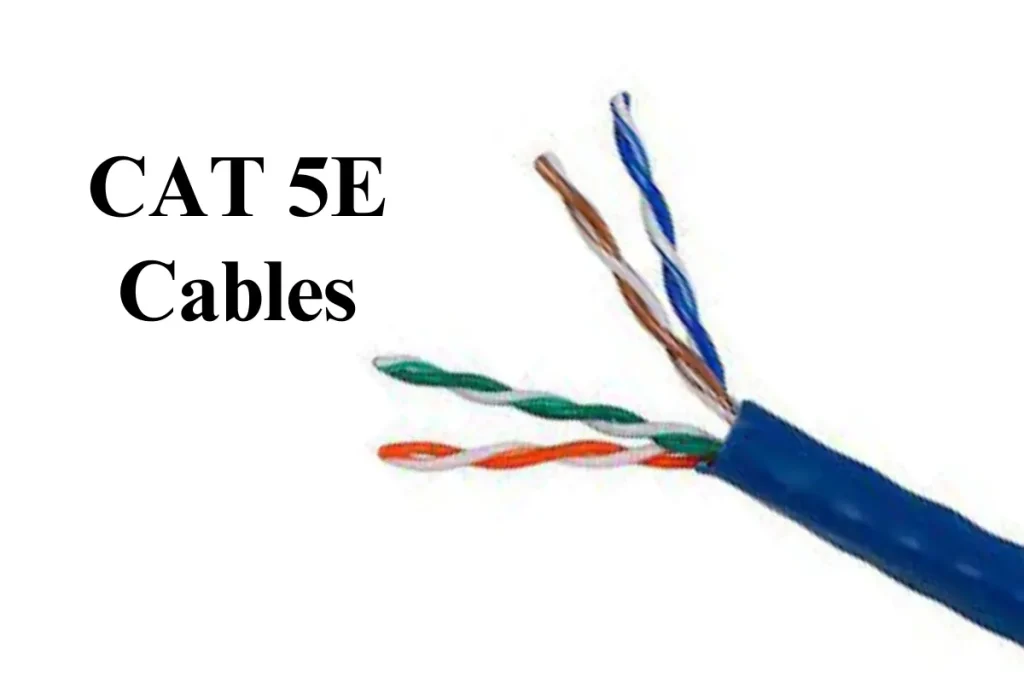
Cat 5e, short for Category 5e, is an enhanced version of the Category 5 cable. It’s designed to support higher data transfer speeds and improved network performance. This type of Ethernet cable is widely used for various applications, including home and office networking, due to its reliability and efficiency.
Cat 5e cables adhere to specific standards that ensure their performance and compatibility. These cables are built to support speeds of up to 1 Gbps and frequencies of up to 100 MHz. They also have reduced crosstalk and improved attenuation, making them a popular choice for networking.
One of the key features of Cat 5e cables is their ability to handle gigabit Ethernet, which makes them suitable for modern high-speed internet connections and data transfer requirements. Additionally, Cat 5e cables are backward compatible with Cat5 networks, allowing for easy upgrades without needing new infrastructure.
Cat 5e Cable Speed and Performance
Cat 5e Speed

Cat 5e cables, also known as Category 5e, are designed to support high-speed data transfer, making them ideal for various networking applications. The maximum speed supported by Cat 5e cables is up to 1 Gbps, which is sufficient for most home and office networks.
This means that Cat 5e cables can handle gigabit Ethernet, providing a reliable and fast connection for internet and data transfer needs.
Comparison of Cat 5e Speed with Other Cables
When comparing Cat 5e cables to other Ethernet cables, such as Cat5 and Cat6, it’s essential to understand their differences in performance and capabilities.
While Cat5 cables were the standard for many years, they have been surpassed by Cat 5e due to the latter’s improved performance and reduced crosstalk. Cat 5e cables can support higher speeds and frequencies, making them a better choice for modern networks.
The Cat5e max speed tops out at 1 Gbps, which is sufficient for most applications. Comparing Cat5e vs Cat6 speed, Cat6 cables can support higher bandwidth and speeds of up to 10 Gbps over shorter distances. The difference between Cat5e and Cat6 lies not only in speed but also in signal interference handling. Cat6 cable speed is faster, making it suitable for high-demand networks. Understanding Cat6 vs Cat5e and Cat6 vs Cat5 helps in deciding which cable best fits your network. If you want to know the difference between Cat5 and Cat6, Cat6 uses thicker copper wires and stricter crosstalk specifications.
However, for most home and office applications, Cat 5e cables provide a cost-effective solution with sufficient speed and performance. Understanding the differences between Cat5 and Cat6 cables can help you make an informed decision about your network setup.
Factors Affecting Cat 5e Performance
Several factors can influence the performance of Cat 5e cables, including the quality of the cable, installation practices, and environmental conditions. Proper installation and avoiding physical damage to the cables are crucial for maintaining optimal performance.
Additionally, using high-quality connectors and ensuring a proper category 5e wiring diagram can help reduce signal loss and interference, further enhancing the performance of Cat 5e cables.
Cat 5e Cable Specifications

Technical Specifications
Cat 5e cables are designed to meet specific technical standards that ensure their performance and reliability. These cables support speeds of up to 1 Gbps and frequencies up to 100 MHz, making them suitable for various networking applications, including Internet, data transfer, and video streaming.
The improved design of Cat 5e cables reduces crosstalk and electromagnetic interference, which can negatively impact signal quality. They are classified as UTP (Unshielded Twisted Pair) cables, means consist of twisted pairs of wires within an outer sheath.
UTP cables are commonly used in networking due to their cost-effectiveness and ease of installation. Cat 5e cables follow a standard pin configuration, which dictates how the wires are arranged within the connector for optimal performance.
Bandwidth and Frequency
One of the key features of Cat 5e cables is their ability to handle high bandwidth and frequencies. The maximum bandwidth supported by Cat 5e cables is 100 MHz, which allows for efficient data transfer and minimal signal loss. This makes Cat 5e cables an ideal choice for gigabit Ethernet networks, where high-speed data transfer is crucial.
Wire Gauge and Construction
Cat 5e cables are typically constructed using 24-gauge copper wires, which provide a good balance between flexibility and performance. The copper wires are twisted into pairs to reduce crosstalk and improve signal quality.
Additionally, Cat 5e cables often come with an outer sheath made of PVC or other materials that protect against physical damage and environmental factors.
Proper cable management, such as daisy chaining, can enhance the performance and organization of your networking setup. The pinout diagram of Cat 5e cables provides a clear reference for aligning conductors correctly within the RJ45 connector.
Testing and Certification
To ensure that Cat 5e cables meet the required performance standards, they undergo rigorous testing and certification processes. These tests include checking for signal attenuation, crosstalk, and overall cable integrity.
Certified Cat 5e cables are labeled with performance ratings and specifications, giving users confidence in their quality and reliability. Knowing the fiber optic color code or connector color code is crucial for correctly identifying and managing cables in more advanced networking environments.
Cat 5e Cable Installation
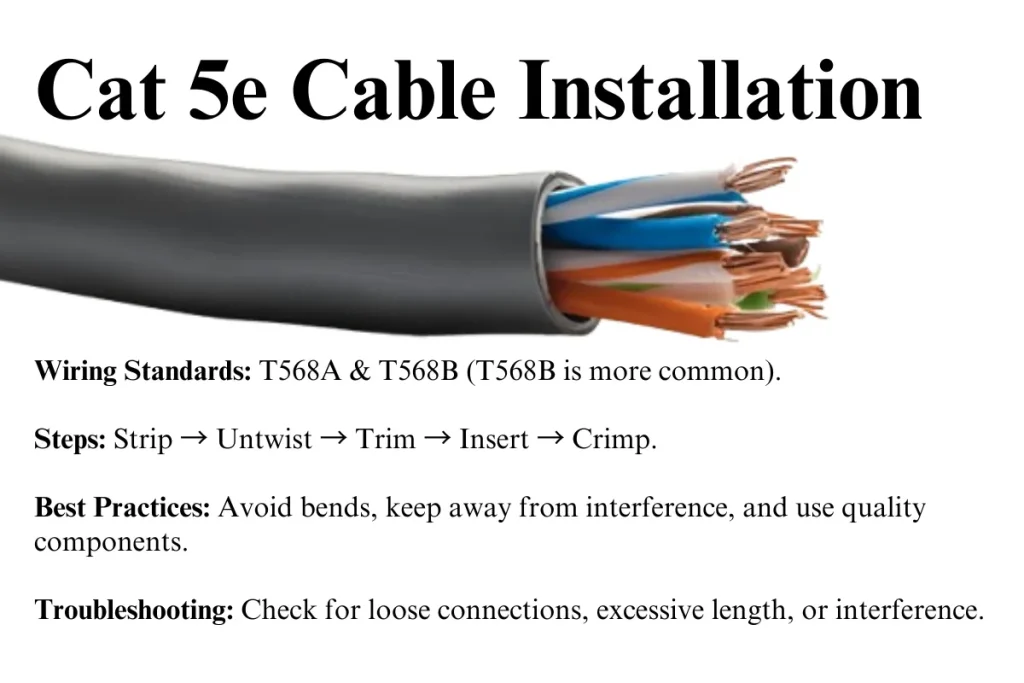
Wiring Guide
Installing Cat 5e ethernet cable wiring guide requires careful planning and adherence to wiring standards to ensure optimal performance. The most common wiring standards for Cat 5e cables are T568A and T568B. Both standards are widely used, but T568B is more common in the United States. To wire a Cat 5e cable, follow these steps:
- Strip the Cable: Remove about 2-3 inches of the outer jacket to expose the twisted pairs of wires.
- Untwist the Pairs: Carefully untwist each pair of wires and arrange them according to the chosen wiring or cat 5e cabling diagram standard (T568A or T568B).
- Trim the Wires: Trim the wires to a uniform length, leaving about 1/2 inch to insert into the connector.
- Insert into Connector: Insert the wires into an RJ45 connector, ensuring each wire order is fully inserted and in the correct order.
- Crimp the Connector: Use a crimping tool to secure the connector to the cable, ensuring a solid and reliable connection.
When setting up a Cat 5e network, following the correct termination diagram ensures proper connectivity and signal integrity. Understanding the pin assignment of Cat 5e cables is essential for achieving the correct wiring and avoiding connection issues.
An accurate RJ45 wiring diagram helps installers correctly terminate Cat 5e cables to ensure reliable network performance. For structured cabling, many installers prefer Type B wiring due to its widespread use in commercial networking environments.
Installation Tips and Best Practices
- Avoid Bending the Cable: Sharp bends and twists can damage the internal wires and degrade performance.
- Maintain Proper Distance: Keep Cat 5e cables away from power lines and sources of electromagnetic interference to avoid signal degradation.
- Use Quality Components: Use high-quality connectors and jacks to ensure reliable plug connections and long-lasting performance.
- Patch Cord Usage: When connecting multiple devices, use a patch cord to bridge the gap between the devices and the network switch.
- Secure Connections: Ensure that each cable is securely connected to its respective port to avoid any connectivity issues.
A well-labeled connector diagram can simplify the installation process, helping users avoid wiring mistakes.
Common Issues and Troubleshooting
- Poor Performance: If your network is experiencing slow speeds or intermittent connectivity, check for loose connections, damaged cables, or improper Cat 5e ethernet cable wiring diagram.
- Signal Loss: Signal loss can occur due to excessive cable length or poor-quality cables. Ensure your cables are within the recommended length and are of good quality.
- Interference: Electromagnetic interference from nearby power lines or electronic devices can affect Cat 5e’s performance. Keep your cables away from such sources.
A misconfigured jack wiring diagram can lead to connectivity issues, making it essential to verify the correct setup before installation.
Cat5e performance can be affected by electromagnetic or magnetic interference, making this a relevant connection.
Cat 5e Cable Applications

Use Cases and Applications
Cat 5e cables are versatile and can be used in various networking scenarios. They are commonly found in residential, commercial, and industrial settings. Some typical applications include:
- Home Networking: Cat 5e cables are ideal for setting up home networks and connecting routers, switches, and other devices to ensure high-speed internet access and seamless data transfer.
- Office Networking: In office environments, Cat 5e cables are used to connect workstations, servers, and other network devices, providing a reliable and efficient networking solution.
- Video Streaming and Gaming: Cat 5e cables can handle the high bandwidth requirements of video streaming and online gaming, ensuring smooth and lag-free experiences.
When setting up your home or office network, ensure that your devices, such as headphones, are placed carefully to prevent damage while managing cables.
Compatibility with Devices
Cat 5e cables are compatible with a wide range of devices, including computers, routers, switches, modems, and gaming consoles. They support gigabit Ethernet, making them suitable for high-speed internet connections and data transfer. Additionally, Cat 5e cables are backward compatible with older networking equipment, ensuring seamless integration into existing networks.
Benefits of Using Cat 5e Cables
Using Cat 5e cables offers several advantages, including:
- Cost-Effective: Cat 5e cables are relatively inexpensive compared to higher-category cables like Cat6 and Cat7, making them a cost-effective solution for most networking needs.
- Easy Installation: Cat 5e cables are easy to install and work with, making them a popular choice for DIY networking projects.
- Reliable Performance: Cat 5e cables provide reliable and consistent performance, ensuring stable and fast connections for various applications.
- Future-Proofing: While Cat 5e cables may not offer the same performance as newer cable categories, they still provide sufficient speed and bandwidth for most current applications, making them a practical choice for future-proofing your network.
Cat 5e vs Ethernet Cables
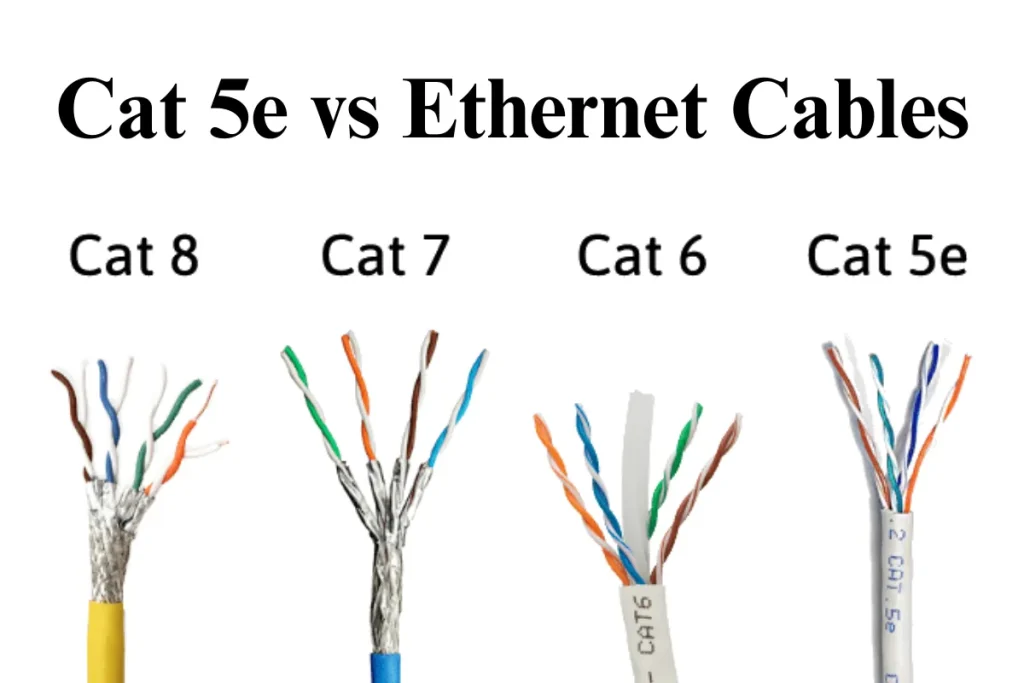
Comparison of Specifications
For more advanced networks, knowing Cat5e vs Cat6a or Cat5e vs Cat6e is essential. Cat6e cables and Cat6e speed provide faster data rates and better performance over longer distances compared to Cat5e.
The cat6a vs 6e debate focuses on maximum bandwidth and cable shielding. When comparing Cat5 vs Cat6 vs Cat7, Cat7 cables offer higher frequencies and advanced shielding, but Cat5e vs Cat6 vs Cat7 remains cost-effective for most home users.
Consider the Cat6 max length for gigabit and Cat6e max length when planning your layout. Different Cat6 cable types and the Cat6 cord selection can affect overall network efficiency. The table below highlights the key specifications and differences:
|
Feature |
Cat 5e |
Cat5 |
Cat6 |
|
Maximum Speed |
Up to 1 Gbps |
Up to 100 Mbps |
Up to 10 Gbps (short distances) |
|
Max Frequency |
100 MHz |
100 MHz |
250 MHz |
|
Maximum Length |
100 meters (328 feet) |
100 meters (328 feet) |
100 meters (328 feet) |
|
Crosstalk |
Reduced |
Higher |
Significantly Reduced |
|
Typical Usage |
Home and Office Networking |
Basic Networking |
High-Speed Networks |
|
Cost |
Moderate |
Low |
Higher |
Pros and Cons of Cat 5e Cables
Cat 5e cables offer several advantages and disadvantages compared to other Ethernet cables:
|
Pros |
Cons |
|
Cost-effective |
Lower performance compared to Cat6 |
|
Easy to install and work with |
Limited to 1 Gbps speed |
|
Suitable for most home and office networks |
Higher crosstalk than Cat6 |
|
Backward compatible with Cat5 equipment |
Not suitable for very high-speed networks |
Cat 5e cables provide a balanced solution for many networking needs, offering good performance at a reasonable price. However, for environments requiring very high speeds and minimal interference, Cat 6 cables may be a better choice.
Cat 5e Cable Maintenance and Upgrades

Proper Maintenance and Care
Maintaining your Cat 5e cables is essential for ensuring their longevity and optimal performance. Here are some tips to keep your cables in top condition:
- Avoid Physical Damage: Protect your cables from sharp bends, kinks, and heavy objects that could crush or damage them.
- Regular Inspections: Periodically check your cables for signs of wear and tear, such as fraying or exposed wires. Replace damaged cables promptly.
- Proper Storage: Store excess cables neatly, avoiding tangles and twists that could cause damage over time.
When to Upgrade Your Cables
Knowing when to upgrade your Cat 5e cables is crucial for maintaining a high-performing network. Consider upgrading your cables if you experience any of the following:
- Slow Network Speeds: If your network is consistently slow, it might be time to upgrade to higher-category cables like Cat6 or Cat7.
- Intermittent Connectivity: Frequent drops in connectivity could indicate that your Cat 5e cables are no longer sufficient for your network needs.
- Increased Network Demands: As your network usage grows, you might need cables with higher bandwidth and speed capabilities to accommodate increased data traffic.
Future-Proofing Your Network
For future-proofing, consider the Cat5e max speed and Cat5e gigabit capabilities. Checking Ethernet cable ratings, Cat5e spec, and Cat5e data cable quality ensures long-term reliability.
With Cat5e maximum speed, you can upgrade network devices without immediately replacing cables, balancing cost and performance.
- Cat 6 Cables: These cables support speeds up to 10 Gbps over shorter distances and provide improved performance and reduced crosstalk compared to Cat 5e.
- Cat7 Cables: With even higher speeds and bandwidth capabilities, Cat7 cables are suitable for high-performance networks and future-proofing your infrastructure.
- Cat8 Cables: These cables offer the highest performance and speed capabilities, making them ideal for data centers and high-demand applications.
Conclusion
Understanding the capabilities and specifications of Cat 5e cables is essential for optimizing your network performance. These reliable and cost-effective cables provide the speed and bandwidth necessary for most home and office applications.
By choosing the right Cat 5e cables and following best installation practices, you can ensure a stable and efficient network that meets your current and future needs.
FAQs
Is Cat5e better than CAT6?
While Cat5e cables are cost-effective and sufficient for many applications, Cat6 cables offer better performance. Cat6 cables support higher speeds of up to 10 Gbps over shorter distances and provide improved crosstalk and interference reduction. However, for most home and small office networks, Cat5e cables provide adequate performance at a lower cost.
What is Cat5e cable used for?
Cat5e cables are used for various networking applications, including connecting computers, routers, switches, and other devices in the home and office networks. They are also suitable for video streaming, online gaming, and other high-bandwidth activities.
Can a Cat5 run 1000 Mbps?
Standard Cat5 cables are typically limited to speeds of up to 100 Mbps. However, Cat5e cables, an enhanced version of Cat5, can support speeds of up to 1 Gbps (1000 Mbps), making them suitable for gigabit Ethernet.
Can Cat5e support Gigabit Ethernet?
Yes, Cat5e cables are designed to support gigabit Ethernet, which means they can handle data transfer speeds of up to 1 Gbps. This makes them an excellent choice for most home and office networks that require high-speed internet and data transfer capabilities.
What Ethernet cable do I need?
Choosing the right Ethernet cable depends on your network requirements. Consider factors like speed, distance, and the devices you are connecting to ensure optimal performance.
Does the Ethernet cable matter?
Yes, the type of Ethernet cable matters because it affects network speed, stability, and overall performance. Using the correct cable ensures reliable connectivity.
Is Cat6 better than Cat5e?
Yes, Cat6 is better than Cat5e for high-speed network needs, offering higher bandwidth, reduced interference, and faster data transfer rates.

